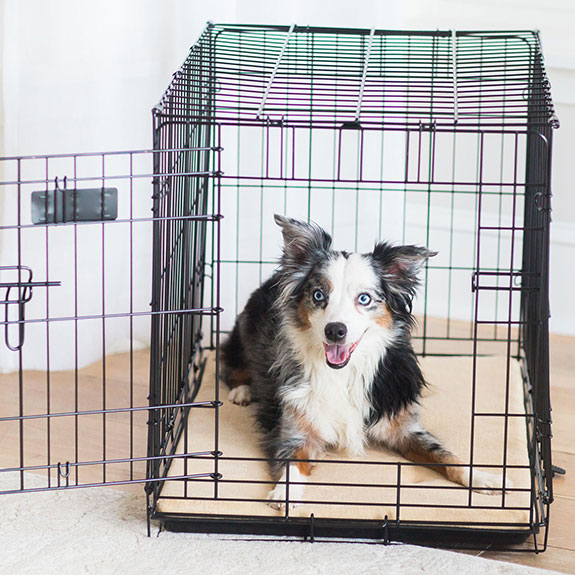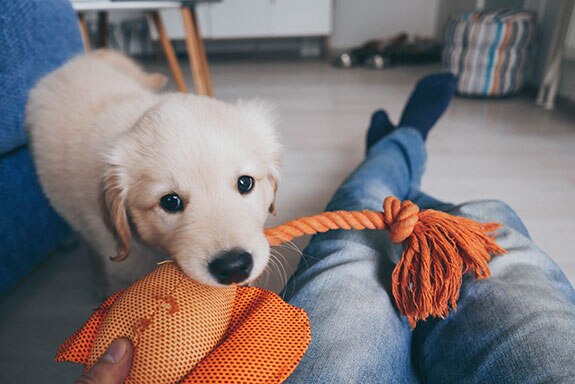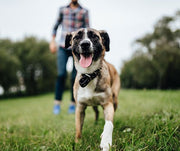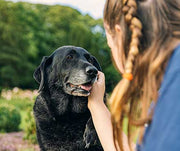Puppy Training Tips

There are few joys like that of bringing home a new puppy. Having a training plan on the first day – and applying it consistently – will help that joyous feeling last. Below are a few areas of basic training to target first.
House Training
House accidents are one of the number one reasons why owners give up their dogs. To avoid frustrations for both you and your puppy – and damage to your floors – it's key that you begin house training your puppy right away. If your little one is pacing, sniffing, or whining, it could be a sign that it's time to head outside.
As you get to know your puppy, you'll learn what to watch out for and you'll learn your puppy's communication styles. Until then, it's important to be proactive about establishing a potty routine. Because puppies can't hold their bladders as long as adult dogs, experts recommend taking your puppy outside every few hours. Placing training pads strategically around your house can help limit the damage and frustration that comes from accidents.
Remember, do not hit or yell at your puppy if he accidentally uses the restroom in your home. Accidents happen, and patience is key during the potty training phase. If your puppy is having trouble catching along to going potty outdoors, try positive reinforcement with a treat or toy any time he successfully uses the restroom outside. Now, let's move on to Crate Training.
Crate Training a Puppy

Kennels and crates are not puppy jails. Instead, they provide a safe, dedicated space for your puppy that gives them a sense of security and a safe place to rest. It's important that you purchase a crate or kennel that's sized just right for your puppy. While a bigger crate may seem like a good choice, having a crate that's too large will give your puppy room to use the restroom.
A crate should be just big enough for your puppy to walk in, turn around, and lay down comfortably. They do not need any more room than that. When you first introduce your puppy to their crate, start slow. Place a kennel mat inside, keep the door open, and let your puppy explore on their own. Once your puppy is comfortable with getting inside, close the door for a few minutes. If your puppy starts to whine or stress out, be sure to provide comfort.
Once your puppy is used to sitting in his crate for 10-15 minutes at a time, you can start leaving him alone. However, you should never leave your puppy alone in a crate for more than a couple of hours at a time. So be sure you have a plan in place to run home and let your puppy out to use the restroom if you're going to be gone for more than a few hours. Remember, it can take up to 6 months to establish a good crate routine, so patience is especially important.
Leash Training
To prepare your puppy for the least, start by having her wear her harness or collar indoors during play and feeding times. While still indoors, walk her on the leash and practice establishing a voice command to make her come to you. When your puppy does come to you, reward her with a treat. Once you have established a basic command for your dog, it's time to head outside. Your dog's natural tendency on the leash is to pull. For more control over your puppy, experts recommend a harness and a lead. Using a harness and a lead gives you much more control over your dog so that you're walking your dog. Not the other way around.
Dealing with Puppy Nips and Bites

Puppies are mouthy by nature, so your little one is bound to get a hold of something she shouldn't have, including your hand! When your puppy bites your hand during play, experts suggest shouting "Ouch!" in a deliberate manner, to demonstrate that biting takes away from playtime with you. If your puppy bites or nips at you, immediately give your puppy safe, acceptable puppy toys to redirect his chewing. Also, be sure to reinforce gentle play with affirmation and treats.
Conclusion
Bringing home a new puppy is exciting but also a major responsibility. With a lot of patience and by providing your puppy with a consistent schedule, you'll have your puppy trained in no time at all!
Previous article

Next article

Related posts
View all-

What is the Best Scent to Mask Cat Box Odors?
If you share your home with a cat, you know how important it is to keep their litter box fresh and odor-free. A clean litter box improves your home’s air quality and ensures your furry friend feels comfortable using it. However, masking litter box odors can be tricky, especially if you have more than one cat or the smell of cat urine seems impossible to control.
Read Article -

How To Celebrate National Puppy Day
Let's face it. Puppies are absolutely one of the cutest creatures on this planet. From their fresh puppy breath to their adoring puppy eyes to their loving puppy cuddles, puppies have been capturing the hearts of millions for generations. Read Article -

Can My Dog Learn to Use the Cat Litter Box?
Some owners wonder: can dogs learn to use a cat litter box? It’s a practical solution for small, older, and even puppies. If cats can do it, why not our canine companions? The idea sounds simple enough, but it’s not as straightforward as tossing down a litter pan and expecting results. Dogs have different instincts, and training methods vary. Without the correct litter box, consistent training, and proper rewards, it may seem impossible.
Read Article



